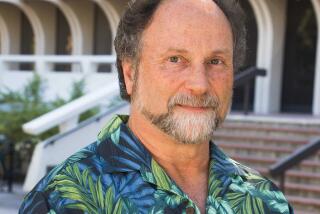Troubling quake pattern found
Large earthquakes have rumbled along a southern section of the San Andreas fault more frequently than previously believed, suggesting that Southern California could be overdue for a strong temblor on the notorious fault line, a new study has found.
The Carrizo Plain section of the San Andreas has not seen a massive quake since the much-researched Fort Tejon temblor of 1857, which at an estimated magnitude of 7.9 is considered the most powerful earthquake to hit Southern California in modern times.
But the new research by UC Irvine scientists, to be published next week, found that major quakes occurred there roughly every 137 years over the last 700 years. Until now, scientists believed big quakes occurred along the fault roughly every 200 years.
The findings are significant because seismologists have long believed this portion of the fault is capable of sparking the so-called Big One that officials have for decades warned will eventually occur in Southern California.
“It’s been long enough since 1857 that we should be concerned about another great earthquake that ruptures through this part of the fault,” said Ken Hudnut, a geophysicist at the U.S. Geological Survey in Pasadena who was not involved in the study.
Many scientists thought the Carrizo area produced relatively infrequent but large-scale earthquakes such as the Fort Tejon temblor. The new work suggests the area produces more quakes but also ones of a smaller magnitude than Fort Tejon, said Ray Weldon, a University of Oregon geologist who was not involved in the research but reviewed the paper for the Journal of Geophysical Research.
Such temblors, experts warned, would likely be at least as big as the 1994 Northridge quake, which had a magnitude of 6.7.
“Even moderate earthquakes on the San Andreas can cause considerable damage, so the overall hazard and risk has gone up,” Weldon said.
The section of the San Andreas fault threading through the dry Carrizo Plain is one of the most famous and photographed parts of the fault because creek beds and other features on one side of the fault have clearly shifted away from matching features on the other side. About 100 miles northwest of Los Angeles, the Carrizo area was one of the main sections that ruptured in the 1857 quake. That rupture, roaring southwest into the Los Angeles Basin, rocked parts of the region so hard that men were thrown to the ground.
Lisa Grant Ludwig, a principal investigator on the study, first visited the Carrizo Plain about 20 years ago, digging trenches in an area west of the Panorama Hills known as the Bidart Fan.
By looking at the pattern of soils and using radiocarbon dating on charcoal deposits, she found evidence of five large earthquakes dating back to the early 1200s. She found a gap of some 400 years between the 1857 earthquake and the one before, but only about 100 years separating the three preceding quakes.
Back then, the earthquake age estimates were very rough and the samples had to be fairly large, about the size of a jelly bean. Ludwig saved field notes and hundreds of soil samples in glass vials in her garage for more than 15 years, hoping that radiocarbon dating techniques would improve.
Once the technology improved, Ludwig and her colleagues could date samples with much higher precision and analyze charcoal flakes as small as the tip of a pencil.
They went back to her archive, and the redating effort, led by scholar Sinan Akciz, found that the four big earthquakes before the 1857 temblor probably occurred around 1310, 1393, 1585 and 1640.
“We were better able to constrain the dates and show that actually these five earthquakes were pretty evenly spaced,” Ludwig said.
Because they are looking at only a handful of earthquakes, scientists can’t be sure that the pattern will hold, Ludwig said.
“But we know it increases the probability of an earthquake,” she said. “There’s not any way I can look at the data and be comforted by it.”
Ludwig’s team has dug some new trenches in the area to supplement the redating project, hoping to find new soil samples that show the increased frequency of large earthquakes.
Results won’t be finalized for a few months, Ludwig said, but preliminary analysis suggests that the time interval between earthquakes may be even shorter, something on the order of 100 years.
--
More to Read
Sign up for Essential California
The most important California stories and recommendations in your inbox every morning.
You may occasionally receive promotional content from the Los Angeles Times.










